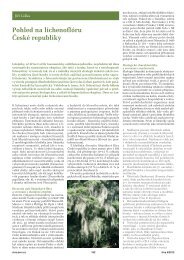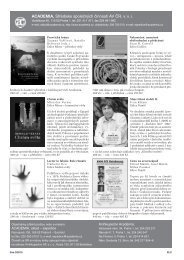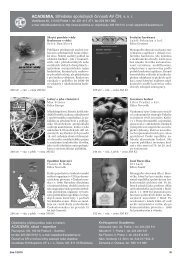Článek v PDF ke stažení - Živa - Akademie věd ČR
Článek v PDF ke stažení - Živa - Akademie věd ČR
Článek v PDF ke stažení - Živa - Akademie věd ČR
You also want an ePaper? Increase the reach of your titles
YUMPU automatically turns print PDFs into web optimized ePapers that Google loves.
Summary<br />
Ložek V., Juřičková L.: Stream<br />
Corridors, Alluvia and Molluscs I.<br />
The Term Alluvium, Its Definition and<br />
Its Status in the Flood Plain Ecosystem<br />
The importance of stream corridors and<br />
flood deposits for the spreading of molluscs<br />
is demonstrated using some examples<br />
from the Czech territory. Three types<br />
of floodplain debris, which contain shell<br />
accumulation, are distinguished: allochtonous<br />
debris accumulated by river flow on<br />
riversides, autochtonous accumulation in<br />
quiet parts of alluvium far from the main<br />
flow, and accumulation caused by strong<br />
turbulence during flooding.<br />
Rulík M.: Microbial Biofilms 2. Aquatic<br />
Environments<br />
The function of biofilms in natural waters<br />
is driven primarily by mutual interactions<br />
between algae, bacteria and their grazers.<br />
In turn, the grazers together with a hydraulic<br />
regime of the environment may control<br />
the biomass and the thickness of the biofilms<br />
and affect their ability to inta<strong>ke</strong> and<br />
retain nutrients and toxic pollutants. Thus<br />
biofilms represent the hot spots of metabolic<br />
activity which contribute substantially<br />
to water self-purification and serve as food<br />
for invertebrate organisms. However, biofilms<br />
may also show adverse effects on the<br />
surfaces they colonize.<br />
Kubátová A.: Moulds in Households.<br />
Do You Know Your Housemates<br />
Filamentous microscopic fungi (moulds,<br />
predominantly from the phylum Ascomycota),<br />
a very diverse and versatile group of<br />
organisms, are able to colonize any kind of<br />
substrate. This article presents a short<br />
survey of some microfungi inhabiting our<br />
households. Examples are given of toxigenic<br />
fungi, xerophiles, psychrophiles, ne -<br />
crotrophs and sugar fungi.<br />
Khodlová Z., Trávníček P.: Remarkable<br />
Evolutionary History of Unexceptional<br />
Grass – Sweet Vernal Grass and Its<br />
Relatives<br />
Anthoxanthum odoratum (Sweet Vernal<br />
Grass), is a widespread grass species native<br />
to Eurasia and common also in the Czech<br />
Republic. Its name is derived from distinct<br />
scent, particularly strong in dry state, caused<br />
by coumarins. Eight other Anthoxan -<br />
thum species can be found in Europe, one<br />
of which (A. alpinum) occurs in the Czech<br />
Republic. It replaces A. odoratum at higher<br />
altitudes. The genus encompasses both di -<br />
ploids and polyploids that have complex<br />
evolutionary history. We used DNA flow<br />
cytometry together with molecular mar<strong>ke</strong>rs<br />
to gain detailed insights into evolutionary<br />
processes shaping the genus.<br />
Roleček J., Losík J.: Southern Urals<br />
Forest Steppes<br />
The Southern Urals are an inspiring place<br />
for Czech naturalists. This paper provides<br />
basic information on this seldom visited<br />
region and describes the impressions of<br />
the two Czech biologists from their excursion<br />
to this place. The nature of the Sou -<br />
thern Urals captivated them with its wildness,<br />
unrivalled in present-day Central<br />
Europe, its intrinsic order and the similari -<br />
ties with Central European nature.<br />
Pavlovič A.: Carnivorous Plants<br />
of the Genus Nepenthes – Their Special<br />
Strategies for Obtaining Nutrients<br />
Although it has been generally reported<br />
that carnivorous plants of the genus Ne -<br />
penthes are not very selective about their<br />
prey, the new studies have shown that the<br />
genus is under a strong selective pressure<br />
to specialize in certain prey. Moreover, no -<br />
vel nutrient sequestration strategies have<br />
recently been described, including leaf litter<br />
and faeces utilization. Thus the genus Ne -<br />
penthes is a new and illustrative example<br />
of adaptive radiation with regard to nitrogen<br />
sequestration strategy.<br />
Juračka P. J., Horká I., Petrusek A.,<br />
Ďuriš Z.: Stories from the Scanning<br />
Microscope 6. Caribbean Shrimps<br />
with Scissors<br />
Categorizing inter-specific relationships<br />
might be very difficult as the participating<br />
species may play various roles. Using the<br />
example of Caribbean Shrimps (Typton<br />
carneus) we show that it is possible to consider<br />
one interaction to be described as<br />
mutualism, commensalism or parasitism,<br />
depending on our point of view.<br />
Peltanová A., Juřičková L.: One-legged<br />
Interloper Crosses the Czech Landscape<br />
– Mapping the Occurrence<br />
of the Cartusian Snail, 2008–11<br />
In 2008, a call to map out the Cartusian<br />
Snail’s (Monacha cartusiana) recent distribution<br />
in the Czech Republic was publi -<br />
shed (<strong>Živa</strong> 2008, 2: 73). Due to the useful<br />
help of experts and the general public, the<br />
intensive spread of this non-indigenous<br />
species was observed and described. In<br />
this short report, we discuss inter alia the<br />
changes in distribution of several non-na -<br />
tive land snails species.<br />
Literák I., Literáková Z., Horsák M.,<br />
Hromádko M.: Snails Can Migrate<br />
with Birds – the Common Whitethroat<br />
and the Small Land Snail<br />
Our observations of the Small Land Snail<br />
Vitrina pellucida attached to the plumage<br />
of the Common Whitethroat (Sylvia communis)<br />
provide a further evidence of passive<br />
land snail dispersal by birds over long<br />
distances.<br />
Drag L., Čížek L., Pokluda P. †, Hauck D.,<br />
Honců M., Roztočil O. †: The Alpine<br />
Longicorn and Its Occurrence<br />
in the Czech Republic<br />
The Alpine Longicorn (Rosalia alpina) is<br />
an endangered and strictly protected icon<br />
of saproxylic biodiversity. Here we present<br />
an overview of its distribution in the Czech<br />
Republic, its host plants, and habitat requi -<br />
rements. We also comment upon the fores -<br />
try and conservation management of its<br />
last inhabited sites.<br />
Vrba P., Čížek O., Marhoul P.,<br />
Zámečník J., Beneš J., Konvička M.:<br />
Abandoned Military Land –<br />
an Important Refuge for Butterflies<br />
Abandoned military training ranges are<br />
important biodiversity refuges in the mo -<br />
dern landscape. We surveyed 41 such areas<br />
across the Czech Republic in order to<br />
establish butterfly diversity and abundances.<br />
We found exceptionally high species<br />
richness, including many nationally-threa -<br />
tened rarities li<strong>ke</strong> Phengaris arion, Polyom -<br />
matus dorylas and Zygaena punctum. We<br />
conclude that the high conservational va -<br />
lue of these areas was maintained by the<br />
former army activities, which encouraged<br />
high habitat heterogeneity.<br />
Eliáš J.: Splash Tetra and Its Unusual<br />
Reproduction Strategy<br />
The reproduction of the Splash Tetra (Co -<br />
pella arnoldi), which inhabits the Amazon<br />
freshwater river basin, has its peculiari -<br />
ties. These fish deposit their eggs on the<br />
bottom of leaf blades above the water surface,<br />
where atmospheric moisture is high.<br />
After spawning is over the males remain<br />
beneath the leaf and spray the fertilized<br />
eggs with water so that they do not dry out.<br />
But that is the end of their care for their<br />
offspring. The hatching fry falls from the<br />
leaf back into the water and begin their<br />
independent life. These fish usually start<br />
mass spawning during the rainy season.<br />
Fish breeders are well aware of this fact<br />
and often deliberately arrange similar conditions<br />
for their fish when breeding them<br />
in captivity.<br />
Pluháček J.: Review of Phylogeny<br />
and Taxonomy of Living Deer 3.<br />
Capreolinae – the Largest and Smallest<br />
The last part of the series on cervid taxonomy<br />
involves the subfamily Capreolinae.<br />
This subfamily could be divided into two<br />
clades: an Old World clade including Roe<br />
Deer (Capreolus capreolus, C. pygargus),<br />
Chinese Water Deer (Hydropotes inermis)<br />
and Moose (Alces alces) and a New World<br />
clade including Reindeer (Rangifer tarandus),<br />
Mule Deer (the genus Odocoileus)<br />
and deer of Mesoamerica and South America<br />
(Ozotoceros bezoarticus, Blastocerus<br />
dichotomus and species of the genera Hippocamelus,<br />
Pudu and Mazama). Most of<br />
the species belonging to Capreolinae are<br />
evolutionary young. The evolutionary re -<br />
lationships among extant South American<br />
deer remain unclear. Cervids are the most<br />
successful ungulate family that has ever<br />
colonized South America.<br />
Andreska J.: The Brown Bear –<br />
Its Extermination and Its Return<br />
to the Czech Landscape I.<br />
Detailed knowledge of the circumstances<br />
behind the extermination of particular animal<br />
species is a <strong>ke</strong>y premise for their eventual<br />
return, reintroduction and ongoing<br />
preservation. Data on the presence of the<br />
Brown Bear (Ursus arctos) in the Czech<br />
landscape are usually limited to simple<br />
entries about the day and place where the<br />
last specimens in particular (usually mountainous)<br />
regions were slain. Demand for<br />
more precise data, especially regarding the<br />
last documented presence of bear cubs,<br />
has emerged in respect of the recently<br />
discovered ability of bears to migrate over<br />
long distances. The newly collected data<br />
allowed the author to present a much more<br />
complete historical view of the process of<br />
extermination of the Brown Bear in the<br />
Czech territory.<br />
CXII živa 5/2012










